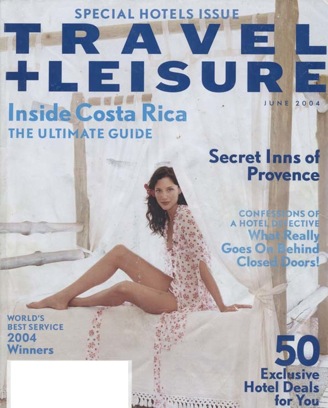
Text by Heidi Sherman Mitchell and Photography by Todd Marshard
With 4 percent of the earth’s wildlife species, vast tropical rain forests, and live volcanoes, it’s no wonder this former backpacker’s haven in Central America has been discovered by the world. If only country were easier to navigate. Here, everything you need to know. A dozen years ago, I spent a summer backpacking through South and Central America. Having lost my glasses somewhere along a four-day hike to Machu Picchu, I arrived in Costa Rica to find a wilderness where green landscapes blurred into turquoise horizons, red volcanic flames bled into the black night, and rainbow-tinted birds streaked across the sky. At that time, basic $20-a-night lodges were the only places to stay, and I moved around by public bus over bumpy roads in search of tiny surfing villages and cloud forests 6,000 feet up.
Nearly everyone I met was an American on a budget, there to catch the waves, study the turtles, and scope out the country’s 10,000 species of plants and more than 230 kinds of mammals before the rest of the world discovered this Eden for themselves.
Even with my fuzzy perspective, I shared their urge to guard the fragile ecosystem of this “rich coast”- as Christopher Columbus named the country in 1502- from the onslaught of mass tourism. Once home, I complained about how developed it was (a lie) and how human intervention was destroying natural habitats (not an untruth: the golden toad, now believed to be extinct, was last seen in 1989). When I returned to Costa Rica a couple of years later- contact lenses, this time- the hues still blended like watercolors and the light breaking through the clouds above the Nicoya Peninsula was just as milky. What had changed was the country’s newfound respect for its precious resources.
In the mid nineties, the government instituted the most progressive reforestation program in the Americas and began an international campaign to market the nation, wedged between Nicaragua and Panama, as an “ecologically friendly” destination. As a result, environmentally conscious backpackers like me were no longer the only ones heading to Costa Rica. Educated visitors with cash to burn flocked to see one of the most biologically varied places on the planet- the Switzerland-sized country is home to 4 percent of the earth’s species of wildlife- and an ecotourism movement was born. Hotels built according to self-imposed conservationist standards couldn’t be put up fast enough. Meanwhile, acres of clear-cut land began to grown back into secondary forests. Much of the guilt associated with being a tourist- contributing to erosion and overconstruction- was alleviated. Gradually, this secret natural world opened up.
This year, Costa Rica is expected to lure 1.2 million visitors, up 20 percent over last year. Following the opening of a Four Seasons resort in January, three major airlines increased direct service from Houston, Miami, and Atlanta into the country’s second-largest airport, Liberia International (40 minutes from the hotel). Farther down the Pacific coast, dozens of equally luxurious boutique hotels have been built, and in the vast tropical reserves that cover 28 percent of the country, a handful of $500-a-night ecolodges have sprung up.
Though an affluent crowd has invaded this painted land, much of Costa Rica- its roads, its glacial pace- continues to try one’s patience. A surfer I met on my first visit gave me some sage advice: Slow down, share the love. His voice has echoed in my head on return trips, and I’ve learned to adopt the mentality of the ticos (as locals are fondly called). I still want to protect the riches, but I no longer feel compelled to distort the facts about overdevelopment (there really isn’t much) or to moan about the disappearing rain forests, which over the past 10 years have begun to reappear. I’ve even learned to laugh about the treacherous roads, which I now navigate with bilingual naturalist divers in private vans rather than by public bus. There’s just one aspect I take issue with: there’s simply too much to do.
…
Osa Peninsula
Time: Five days. In southern Costa Rica, the remote Osa Peninsula is one of the most biologically dense tropical regions on earth. Scarlet macaws do flybys past the lodges, howler monkeys swing from the forest canopy, and whales migrate along the coast. Basically, if it lives and breathes in Costa Rica- caiman, iguana, sloth, jaguar- it probably resides in the nature preserves, public and private, that blanket this peninsula. Some of the world’s first ecolodges were built in the undeveloped jungles of Drake Bay, Golfito, and Corcovado National Park; they are still models of sustainable tourism today.
…
Bosque del Cabo gets less attention but deserves equally high praise. Set at the end of a mile-long drive in another 500-acre preserve, its 13 bungalows have rustic can beds, garden showers, and private sunbathing decks with hammocks. The expert forest guides on staff can take groups hiking, horseback riding, or flying over the trees on the hotel’s zip lines.
…

